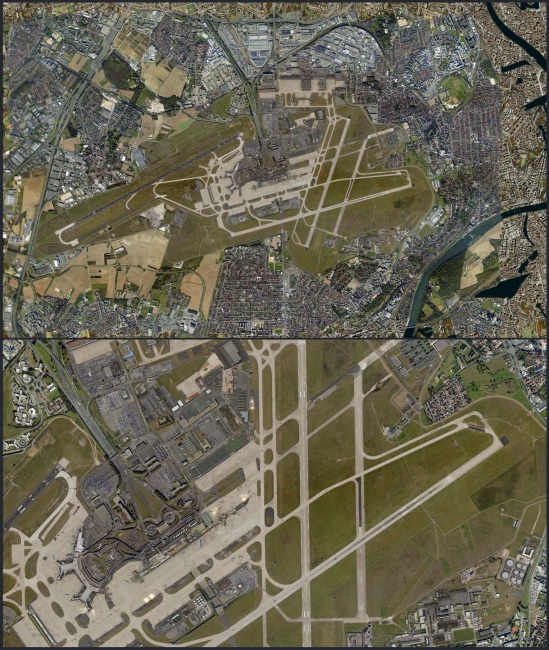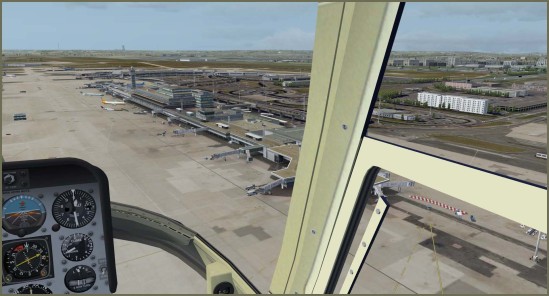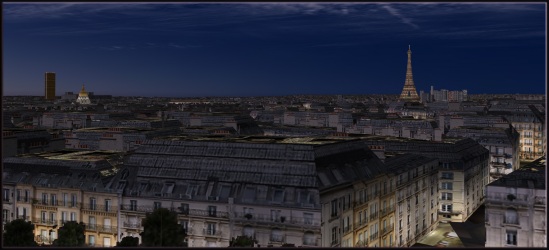Aerosoft’s Mega-Airport Scenery Packs provides some of the best scenery options for enthusiasts flying in MsFS based SIMs, and will soon be available (or so it’s rumored) for users in X-Plane. These efforts have a tremendous reputation for providing ultra-high quality, very immersive ground environments, while X-Plane has garnered a reputation for less than stellar scenery files – generally speaking. This disparity of “opinion” got us thinking: Is this situation real, or simply overblown hype? We’ve heard a lot from people on “both sides” of this debate, so much so that we wondered how one of Aerosoft’s current offerings might compare to an airport X-Plane users regularly cite as “one of the best”.
We chose LFPO Paris Orly for this comparison, and used Aerosoft’s payware LFPO Orly and French-based freeware developer XPFR’s LFPO scenery file, but on the surface this appears an unfair match-up.
Why?
Well, obviously Aerosoft is a large, very successful corporate venture and the file is payware, and relatively expensive payware at that, while XPFR is a group of dedicated freeware developers making all the airports in France available to users in X-Plane. Furthermore, not only is this file is freeware (as are, indeed, all their products), it’s also several years old. Still, XPFR’s LFPO has until quite recently been their most popular download, and even if only subjectively speaking, this file has long been regarded as one of the very best airports in X-Plane – and still is by quite a few people. My guess is that there are really very few add-ons in XP that are held in higher regard, at least by most users, so we’re looking at these two files with only one thought in mind: how does one of the best airports in FsX stack up against one of the best in X-Plane?
And that’s it! No hidden agenda…no ulterior motive. No “this one is better because”, or “that one could use x,y, and z improvements.” Let’s just look and see what they ARE, not what they “should be”, or “might have been” – so let’s look at both without all the noise that attends the usual snarky political infighting that commonly follows such a look.
Okay? Let’s walk through this slowly and take a look around and one step at a time, and just a reminder: most images in this post are quite large, so just click to enlarge!
+++++
Getting Acquainted
And as is our custom around Chaos Manor, we’ll start by looking over the available ground charts and overhead imagery from Google Earth, as this lends valuable reference points and some context for discussion. Charts first:
And Google’s imagery:
A few early comments are in order here. First, this is indeed a huge and very complex airport. The roadways and parking structures by themselves form an impossibly complex maze of visual chaos, and this is a good thing for SIM developers to try and replicate in their work. As we’ve harped on this topic often at XP+10-Reviews there’s little need to mention more than this: visual chaos is good to include in-SIM as it produces distractions that all pilots need to be able to deal with. A SIM is the perfect environment to learn to deal with this often confusing pandemonium, and ALL recreational SIM platforms have in the past failed miserably in this regard. Real airports are simply full of moving objects and confusing lights, while SIM airports tend to be static constructs that are placid and dull in comparison.
Second, concerning the last image just above with the EasyJet A319, this is from Google Earth’s Street View, and LFPO is completely covered in this regard. You can go into GE and simply travel all around the grounds and terminals, rotating your view and checking out all the detail you could ever wish for. If you’d like a more detailed look at the buildings than we can provide here, Street View is where you need to go next.
And now, let’s look at the airports from overhead, in each SIM.
- Aerosoft in FsX with default scenery around the airport visible:
And X-Plane, with XPFR’s LFPO and with default scenery elements visible:
Observations? FsX looks very similar to Google’s imagery; XP’s rendering looks like a 90s vintage video game. Aerosoft’s file has included the all important visual context that surround the immediate airport, thereby enhancing immersive realism. Ignoring issues of flight models and framerates, just ask yourself this: which would you rather use as a training aid?
Now, let’s look at the main terminal building in each SIM, looking from east to west. First up, Aerosoft’s version:
And here’s the comparable view rendered by XPFR’s file from within X-Plane 9.70:
Next, let’s run through some daylight images around the main terminal area in Aerosoft’s creation (again, click to enlarge images):
A couple of quick comments come to mind right off the bat:
Aerosoft’s –
- buildings are accurately scaled, and appear to have excellent textures;
- roadways are a combination of ortho texture and 3D objects, and are expertly shadowed. Only a few small areas in the parking lots look like unconvincing “ortho” textures;
- ramps and parking lots are otherwise realistically filled with static aircraft and other objects.
In the sequence just above, the multi-tiered roadways are quite obviously not simple textures. The effect is striking, and gives the main terminal building total visual credibility. It looks and feels like a congested urban airport. The Dodo Bell Jetranger was getting 30+ FPS, BTW.
Alright, let’s take a quick look around XPFR’s main terminal area, working our way in from the surrounding cityscape, which is very well rendered indeed:
A few observations concerning this scenery for X-Plane:
XPFR’s –
- buildings are reasonable recreations of the originals, but not exactly so;
- the textures suffer from stretching and are quite blurry in places, especially when you move in close;
- the roadways included do not reflect what is on the ground – Period – and detract from the overall success of this effort;
- ramps and aprons are very well done.
- With XPs object render settings at maximum levels, the city around the airport is rendered very well, and provides a nice context, albeit with an extreme performance hit on even newer PCs.
And with these comments in mind, a few more images from XP to consider, especially texture clarity and scale of buildings and roadways:
The Night Landscape
Now let’s turn our attention to the facility at night. Aerosoft first:
Still the overall first impression holds: this looks like a congested urban airport on a hot August night! Some more thoughts and observations?
Aerosoft’s –
- ramps a perfectly rendered, their LIT textures a work of art;
- buildings and Jetways produce multiple shadows from numerous light sources, and pools of light are evenly tapered, producing realistic shaded effects that enhance realism;
- roofs are shadowed and textured to accurately reflect point light sources, but some are too dark while others appear well lit.
Now, some night shots in X-Plane:
Impressions? XPFR’s scenery file is just too dark, and:
- the ramps aren’t LIT and are rendered black,
- buildings are inadequately LIT and details are lost as a result,
- the LIT textures that are employed are uniform and show little directional variety or variation in light intensity
- light fall-off on roof-tops is limited to just a few small textures, hence the buildings appear almost black from above, and ground objects are almost invisible, lost in darkness.
One key element of both these scenery files lies just beyond the airport boundaries: the City of Lights… Paris itself… and both platforms offer a similar approach to the subject. Again, let’s look at FsX’s rendition of Paris first, using default textures and whatever the Aerosoft file has thrown into the mix:
There are some auto-gen structures on the ground, a few extras like Notre Dame, but overall the city is sparsely rendered, rather lackluster and dull. What about after the sun goes down?
Note the view just above, and compare to a similar vantage from XP you’ll find a few images down. Some impressions? This is after all the default landscape in FsX, and yet the city has a bombed-out look, with flattened sections of glowing landscape next to standing buildings. The net effect is not very good.
And so let’s be charitable and say that the default LIT landscape in FsX is somewhat innocuous, and could be improved.
Okay, let’s look at XPFR’s Paris:
Above, the image you should compare to the FsX version, an oft overlooked relationship between monuments in Paris, seen in the highlighted box above, from the new pyramid at the Louvre’s entry court to the Grand Arch de la Defense, passing through the smaller Arch, the Place de la Concorde, and the main Arch…and all perfectly rendered in X-Plane.
And another image to consider: the major architectural triumphs of Paris (above), including the Grand Palais (right), the Eiffel Tower, the Pont Alexander III, and les Invalides with Napoleon’s tomb far left beyond, and again, perfectly executed, and the city a well rendered and complex urban environment.
XPFR’s Paris is a peerless tour de force, and a stunning achievement in any SIM. I simply can’t imagine X-Plane without this file. Looking around this cityscape you can simply see and understand that with proper add-on development XP COULD BE the equal of FsX in this regard.
CONCLUSIONS?
The images tell the story and there’s very little we can add about the comparison between the two platforms that hasn’t been said before. It’s like a match-up between a professional sports team and a talented local school squad…comparing landscapes and airport files in FsX to version 9.xx of X-Plane is almost a pointless exercise – except that XP wants to be taken seriously as a viable platform in the SIM marketplace. It remains competitive as a SIM platform simply because it has a demonstrably more accurate flight model, yet it remains at a competitive disadvantage because third-party add-on developers have been slow to embrace the platform and create the scenery files needed to make the environment a viable option for gamers who crave a more immersive experience. It’s almost a Catch-22 situation, but…
…Laminar’s X-Plane has one good chance just ahead to capture market share: the release of X-Plane 10, which promises to build on previous strengths and address acknowledged weaknesses, namely deficient scenery elements. The new version is slated for release this Christmas (2011), and a lot hinges on a successful product introduction.
So… The real valid comparison between these two airports has yet to be made, and won’t be made until XP10 is up and running, but will XP10 address scenery deficiencies well enough to take on FsX? Will third-party add-on developers cross over to XP in the numbers needed? Well Carenado has crossed over, and successfully too, and Aerosoft’s pending foray into XP is a highly anticipated affair!
And while time will tell, Laminar has simply got to get it right this time out.
Why?
Because the question here that is most germane, and that has not been asked yet, concerns MicroSoft. Let’s ignore that FsX and groups like Aerosoft have developed huge market momentum, because MicroSoft has shelved further development of MsFS. Third-party add-on developers are now stuck with FsX as it is, and they can tweak it and manipulate it’s basic architecture all they want, but the basic problem of a less than optimal flight physics/model will remain. That’s the program’s Achille’s heel, where FsX will always remain weak compared to X-Plane.
So…the Big Question? What impact will MicroSoft’s new MsFlight have on this dynamic, and will the multi-player, gaming oriented new kid on the block somehow make these concerns irrelevant?
The tertiary concerns? Will MsFS developers be able to get in on this new action, and will they in effect have to start from scratch? Or will MsFlight be a closed platform, not open to third party development in a way and to the degree that previous MS platforms have been? If that’s the case, these developers might find that developing for X-Plane is a viable way forward for them. Product innovation and development for a new platform? That equals expansion, and that equals new markets to explore, more money to be made.
Now there’s some food for thought.
We’ll end this little exercise with a little bit of a teaser. Simon is working on tweaking the Paris landscape in FsX with a very powerful scenery enhancement program. We’ll post additions to this article soon. In the meantime, if you have anything you’d like to share just drop us a comment.
Thanks for coming along, and we’ll see you again soon. Chip
+++++
The Aerosoft LFPO file is available here: http://www.aerosoft.com/cgi-local/us/iboshop.cgi?showd480!0,5920563760,10885
System requirements for FSX:
Microsoft Flight Simulator X (SP2, Acceleration or Gold Edition)
Windows 7, Vista, XP
Processor with 3.0 GHz (Core2Duo Intel recommended)
2 GB RAM
3D graphic card with 256 MB, recommended 512 MB
Download-Size: 300 MB
Installations-Size: 540 MB
Current download price, in USD: 29.87
+++++
XPFR’s freeware version of LFPO for X-Plane is available here:
http://xpfr.org/index.php?body=scene_accueil&sc=106
The freeware Paris scenery files are here:




















































Pingback: The News…Heard ‘Round the Ramps…for 9 September 2011 « Xplane10's Blog
Interesting review, but I have a slightly different view. And that’s because the orthophoto’s of Aerosoft look outside the airside not realistic in daylight: the roads, the parkinglots, it doesn’t look sharp and you see the crushed 2D cars. However at night, when your eyes see less details and dimensions it looks ok. So I would prefer the daytime version of XPFR and the night version of Aerosoft.
One thing I didn’t notice earlier is the absence of road chaos at the Champs Elysees and the Place Etoile in X-plane, it even seems that the Champs isn’t paved? Or are there orthophoto’s killing the effect?
The Paris scenery is with the France Roads package installed.
Robert I’m pretty sure the Xpfr scenery in the city does not use orthos, and as chip says, it uses OSM roads. Having been the one who’s flown both, Im happy to say the xplane city roads and monuments are better than the fsx default. However stay tuned for one of our next articles, I’ve found a way to upgrade those hopeless fsx roads!